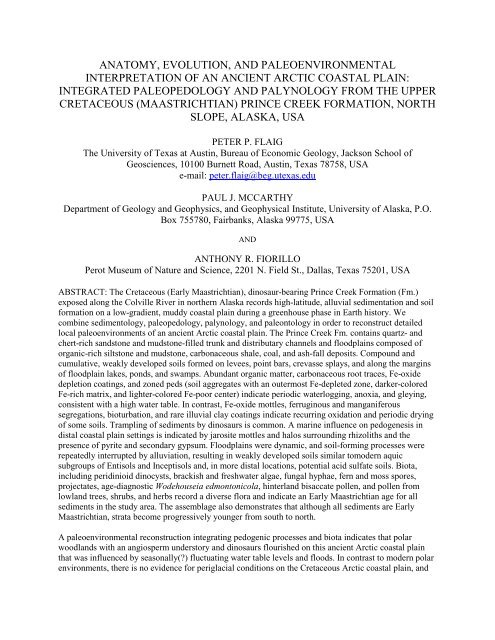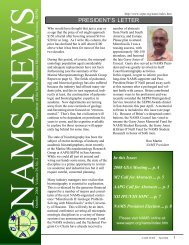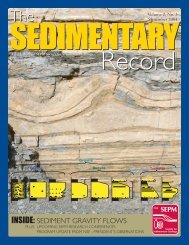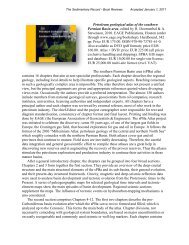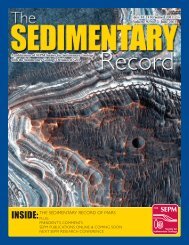PDF of contents and abstracts - SEPM
PDF of contents and abstracts - SEPM
PDF of contents and abstracts - SEPM
You also want an ePaper? Increase the reach of your titles
YUMPU automatically turns print PDFs into web optimized ePapers that Google loves.
ANATOMY, EVOLUTION, AND PALEOENVIRONMENTAL<br />
INTERPRETATION OF AN ANCIENT ARCTIC COASTAL PLAIN:<br />
INTEGRATED PALEOPEDOLOGY AND PALYNOLOGY FROM THE UPPER<br />
CRETACEOUS (MAASTRICHTIAN) PRINCE CREEK FORMATION, NORTH<br />
SLOPE, ALASKA, USA<br />
PETER P. FLAIG<br />
The University <strong>of</strong> Texas at Austin, Bureau <strong>of</strong> Economic Geology, Jackson School <strong>of</strong><br />
Geosciences, 10100 Burnett Road, Austin, Texas 78758, USA<br />
e-mail: peter.flaig@beg.utexas.edu<br />
PAUL J. MCCARTHY<br />
Department <strong>of</strong> Geology <strong>and</strong> Geophysics, <strong>and</strong> Geophysical Institute, University <strong>of</strong> Alaska, P.O.<br />
Box 755780, Fairbanks, Alaska 99775, USA<br />
AND<br />
ANTHONY R. FIORILLO<br />
Perot Museum <strong>of</strong> Nature <strong>and</strong> Science, 2201 N. Field St., Dallas, Texas 75201, USA<br />
ABSTRACT: The Cretaceous (Early Maastrichtian), dinosaur-bearing Prince Creek Formation (Fm.)<br />
exposed along the Colville River in northern Alaska records high-latitude, alluvial sedimentation <strong>and</strong> soil<br />
formation on a low-gradient, muddy coastal plain during a greenhouse phase in Earth history. We<br />
combine sedimentology, paleopedology, palynology, <strong>and</strong> paleontology in order to reconstruct detailed<br />
local paleoenvironments <strong>of</strong> an ancient Arctic coastal plain. The Prince Creek Fm. contains quartz- <strong>and</strong><br />
chert-rich s<strong>and</strong>stone <strong>and</strong> mudstone-filled trunk <strong>and</strong> distributary channels <strong>and</strong> floodplains composed <strong>of</strong><br />
organic-rich siltstone <strong>and</strong> mudstone, carbonaceous shale, coal, <strong>and</strong> ash-fall deposits. Compound <strong>and</strong><br />
cumulative, weakly developed soils formed on levees, point bars, crevasse splays, <strong>and</strong> along the margins<br />
<strong>of</strong> floodplain lakes, ponds, <strong>and</strong> swamps. Abundant organic matter, carbonaceous root traces, Fe-oxide<br />
depletion coatings, <strong>and</strong> zoned peds (soil aggregates with an outermost Fe-depleted zone, darker-colored<br />
Fe-rich matrix, <strong>and</strong> lighter-colored Fe-poor center) indicate periodic waterlogging, anoxia, <strong>and</strong> gleying,<br />
consistent with a high water table. In contrast, Fe-oxide mottles, ferruginous <strong>and</strong> manganiferous<br />
segregations, bioturbation, <strong>and</strong> rare illuvial clay coatings indicate recurring oxidation <strong>and</strong> periodic drying<br />
<strong>of</strong> some soils. Trampling <strong>of</strong> sediments by dinosaurs is common. A marine influence on pedogenesis in<br />
distal coastal plain settings is indicated by jarosite mottles <strong>and</strong> halos surrounding rhizoliths <strong>and</strong> the<br />
presence <strong>of</strong> pyrite <strong>and</strong> secondary gypsum. Floodplains were dynamic, <strong>and</strong> soil-forming processes were<br />
repeatedly interrupted by alluviation, resulting in weakly developed soils similar tomodern aquic<br />
subgroups <strong>of</strong> Entisols <strong>and</strong> Inceptisols <strong>and</strong>, in more distal locations, potential acid sulfate soils. Biota,<br />
including peridinioid dinocysts, brackish <strong>and</strong> freshwater algae, fungal hyphae, fern <strong>and</strong> moss spores,<br />
projectates, age-diagnostic Wodehouseia edmontonicola, hinterl<strong>and</strong> bisaccate pollen, <strong>and</strong> pollen from<br />
lowl<strong>and</strong> trees, shrubs, <strong>and</strong> herbs record a diverse flora <strong>and</strong> indicate an Early Maastrichtian age for all<br />
sediments in the study area. The assemblage also demonstrates that although all sediments are Early<br />
Maastrichtian, strata become progressively younger from south to north.<br />
A paleoenvironmental reconstruction integrating pedogenic processes <strong>and</strong> biota indicates that polar<br />
woodl<strong>and</strong>s with an angiosperm understory <strong>and</strong> dinosaurs flourished on this ancient Arctic coastal plain<br />
that was influenced by seasonally(?) fluctuating water table levels <strong>and</strong> floods. In contrast to modern polar<br />
environments, there is no evidence for periglacial conditions on the Cretaceous Arctic coastal plain, <strong>and</strong>


